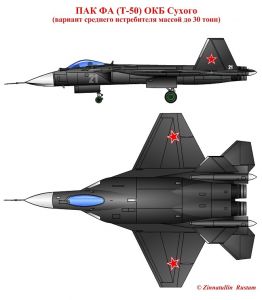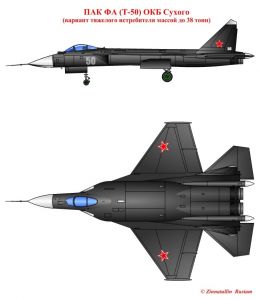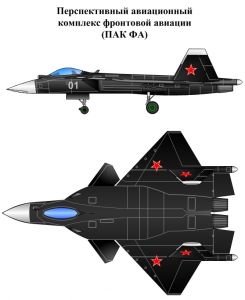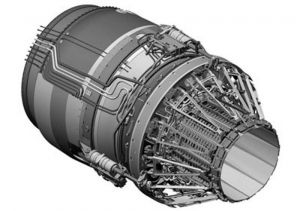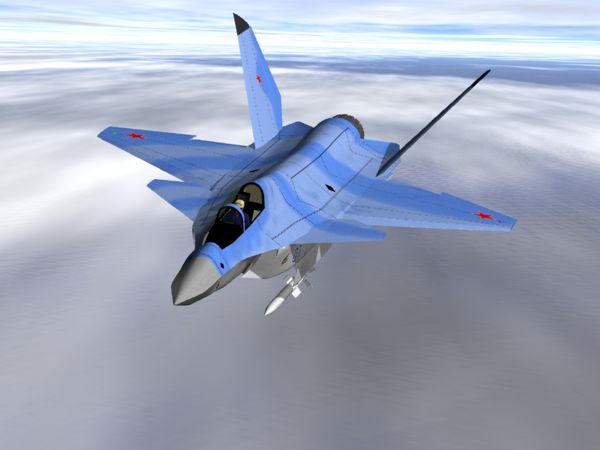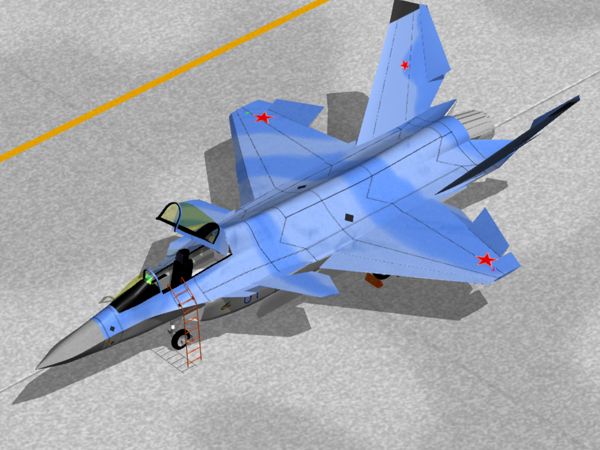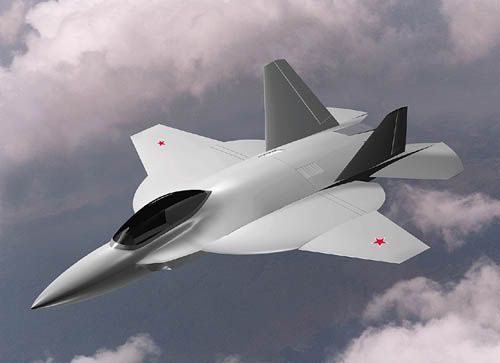Ok, next up, the Sukhoi T-50. No-one knows much about it so these are entirely speculative, but it will be the big world aircraft from the end of this year onward when it comes to military air combat planning for Western (and no doubt many Eastern) air forces.
Codename: PAK FA (this is the name for the programme to develop the fighter, not the name of the fighter itself, but it's what everyone calls it.)
Country: Russian Federation
Manufacturer: Kosomolsk-on-Amur Aircraft Production Organisation (KnAAPO) for the Sukhoi OKB design bureau of the Russian United Aircraft Corporation
Service Years: 0 (Flight testing to start August 2009 at latest estimate.)
Role: Most likely air superiority, counter-IADS and survivable battlefield tactical strike
Designation: T-50 (note this is Sukhoi OKB's internal prototype designation and the aircraft will be given a regular Su-XX designation in official service)
Max Speed: Unknown. Likely in the region of Mach 2.5 based on known capabilities of the NPO Saturn AL-41F engine, which was tested in the Mikoyan-Gurevich 1.44 experimental technology demonstrator. Note the AL-41F will not be ready for the first flights of the T-50 prototype, which will use the 117S, an upgraded version of the AL-31F series that has powered all Flanker series fighters.
Cruise Speed: In excess of Mach 1, likely higher than Mach 1.5.
Supercruise: Yes, this is a confirmed capability.
Turning Radius: Very small (hyper-manoeuvrability is a stated design goal).
Rate of Climb: Unknown.
Unit Cost: As yet unknown. I would estimate it is unlikely the aircraft will exceed an equivalent of $100,000 US because the Russian military will demand a platform that is cost-effective to field as a replacement for the 800-odd MiG-29s and Su-27 variants.
Number Built: Zero complete, three undergoing various stages of pre-flight testing at KnAAPO works under high security.
Fear Factor: Total unknown. Probably used to scare politicians into buying more F-35s and F-22s, not that the latter will work with the production line looking set to be closed down and destroyed.
Armament (as in what is available for it): Unknown. Current Russian inventory which will almost certainly be cleared for the T-50 includes: short-range Vympel R-74M (AA-12 'Archer') digital all-aspect-targeting infra-red homing air-to-air missile (range: ~30km), medium/long-range Vympel R-77M1 'AMRAAMski' (AA-11 'Adder') active radar homing air-to-air missile and variants (including anti-radiation and infra-red homing versions) (range: ~175km), 'Kh-58M' air-to-surface anti-radiation missile (one of the few 'knowns'; it's been confirmed that a shortened variant of the base Kh-58 - 'AS-11 'Kilter' - has been specifically developed to fit the PAK FA's weapons bays) (range ~100km), ultra-long-range Novator KS-172 active radar homing air-to-air missile (range ~400km, intended for use against tankers, AWACS, bombers, maritime patrol aircraft and other large targets rather than fighters, very high probability of evolved versions having ASAT capability, not yet fielded operationally, still in testing.). Probably many other weapons including new-generation AAMs and a lot of air-to-surface weaponry I haven't listed here, but since it's all unknown I've listed only the 'almost-certains' and not the 'possibles' or we'd be here all day.
Thrust Vectoring (2D/3D): 3D (confirmed)
Stealth (degree of RCS reduction): Completely up in the air. Likely 'very low observable' (~0.001-0.0001m^2) but no-one really knows and isn't likely to for a long time. Whether Russia will be able to produce a stealth aircraft that matches the superlative capabilities of the Raptor on their first try is very unlikely, but they do have extensive experience with RAM.
Fame/Infamy: None... yet.
Combat Radius: Unknown. Probably pretty decent because it'll be Flanker-ish in size with no drag from external stores. I'd peg it at somewhere between 500 and 700km.
Ferry Range: Totally unknown.
Status: In development, first flight projected as August 12, 2009.
Kills: None.
Shot-Down: None.
Kill-to-Killed Ratio: Obviously none available.
Service Ceiling: Probably very high (AL-41F was, like the F119 in the F-22, designed for excellent high-altitude performance. Probably well in excess of 60,000ft).
Take-Off Load (Max): Unknown.
Radar Capability: Unknown. Probably an AESA variant of the Bars/Irbis radars fitted to Flankers. Likely to have a large aperture and huge power and range based on experience, but not necessarily all the mod cons because Russia's only built one AESA so far and that's been fitted to the MiG-35. Still a big improvement over their existing radar tech, which is pretty formidable.
MAWS: Yes, fully integrated.
RWR: Yes.
Communications: Stealthy sharing of information available.
Bringback Load: N/A
Landing Length (if VTOL state so): Unknown. Probably not in excess of 500m.
Takeoff Length (if VTOL state so): Unknown. Probably not in excess of 400m.
Primary Users: VVS (Russian Air Force), Indian Air Force (as FGFA variant)
Variants: 'FGFA' ('T-50MKI') two-seat long range version for IAF
PAK FA is arguably a more important programme than the Raptor these days. When it flies, it will show us exactly what Russia and her allies will be using to contest US (and, increasingly, Chinese) air superiority, an utterly vital component of military geopolitics. Most estimations are based entirely on guesswork. What's certain is that it will be more capable than anything Russia currently flies and have stealth to boot. The degree of stealth is totally up in the air and no-one will even have a decent estimate until they see what it actually looks like, and even then, it'll have to be taken with a grain of salt. Mine are based on the fact that it's
probably not going to be at all high and
probably not going to be hyper-low either.
It's also had a rather tangled development period (as usual). It was first meant to fly in 2007, then they shifted it to 2008, and now it's in August 2009, so no-one's really sure where they're at, especially as no-one knows what on Earth it looks like or any of the key specifications for certain. Consider what's here an varying-degrees-of-informed estimate rather than anything for sure.
Perhaps the biggest innovation to come to the Russian aircraft industry in the T-50 will be the concept of sensor fusion and digital information sharing. While it's again unlikely to match the hugely advanced systems on the F-35 in particular in this respect it's not going to be a slouch; the Su-35BM has a degree of of these capabilities already. Sensor fusion effectively means making all your aircraft sensors (the radar, radar warning receiver, ESM gear, missile approach warning system, infra-red search systems and electro-optical cameras) in all areas work together and come together to provide a single picture to the pilot. What this effectively means is that in combination with a helmet-mounted display, the pilot need not be limited by what he can see out of his canopy; with the right software, a pilot might be able to look 'through the floor' of the aircraft, with a camera showing him where his target is in relation to him even though he can't see it, or with ESM giving a simple, consistent signature shown straight to the pilot in visual form instead of him having to examine frequencies, screens and other independent sources of information. Because Russian industry has traditionally been behind the west in electronics and computers, it's the fall of the Soviet Union which has finally allowed them to leap the gap and finally catch up. Again, it might not match the USA's efforts, but it's a big step because it increases a pilot's awareness of the battlespace exponentially.
One important point to make about PAK FA is that they're doing joint development with India's Hindustan Aerospace Limited in what is called the Fifth Generation Fighter Aircraft (FGFA) programme. As Indian requirements are different to Russian (two-seater as opposed to one-seater, longer range, Indian technology contribution) the programme is probably more of a question of Russia doing the development and India providing a portion of the cash and helping with their own version in avionics, electronics, specialised additions et cetera. The FGFA is probably not going to be around until the middle of the next decade however.
Edited by CommanderJB, 03 January 2009 - 12:50.














